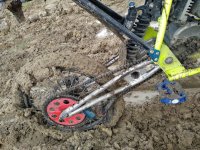Overclocker
10 kW

so my bearings went bad again after just a few months! these are 6805-2rs. 25 x 37 x 7mm. the bearing balls are just too small for heavy-duty ebike applications
so now i'm thinking of upgrading these hubs to bigger bearings. 6904 (20 x 37 x 9mm). same 37mm O.D. but 2mm wider so would stick out 2mm on both sides. 20mm I.D. so bearing would sit directly on the thru-axle (some hubs are actually designed this way)
any thoughts?


